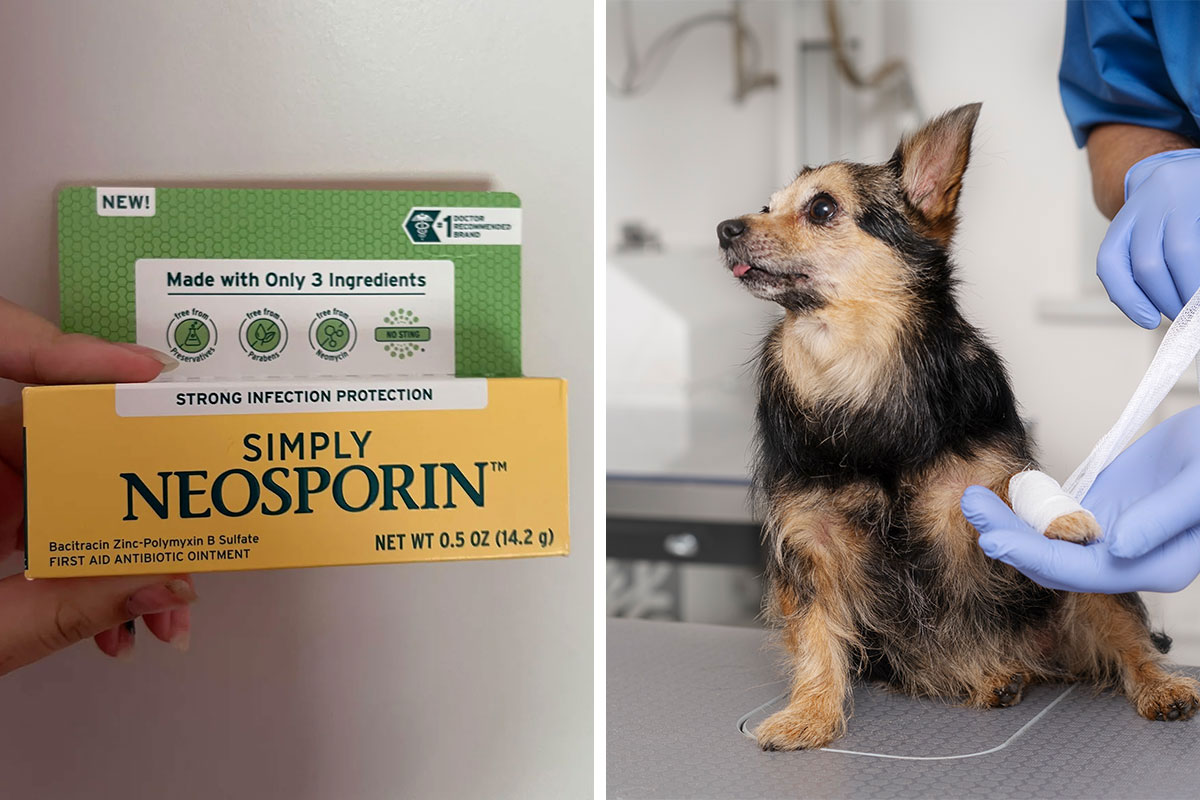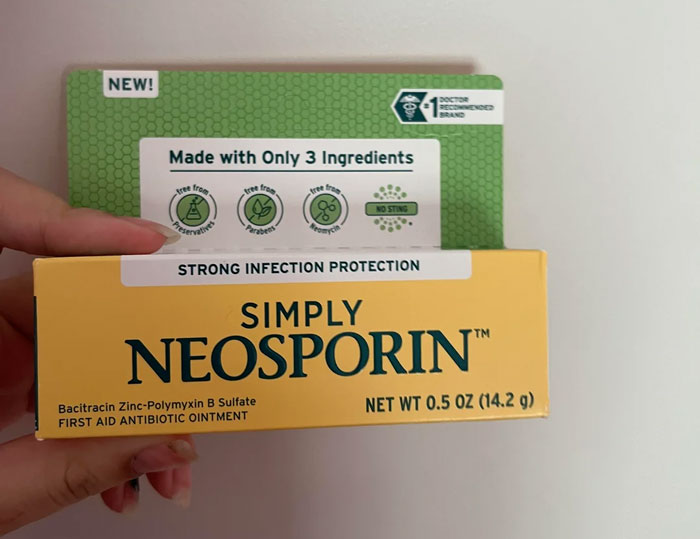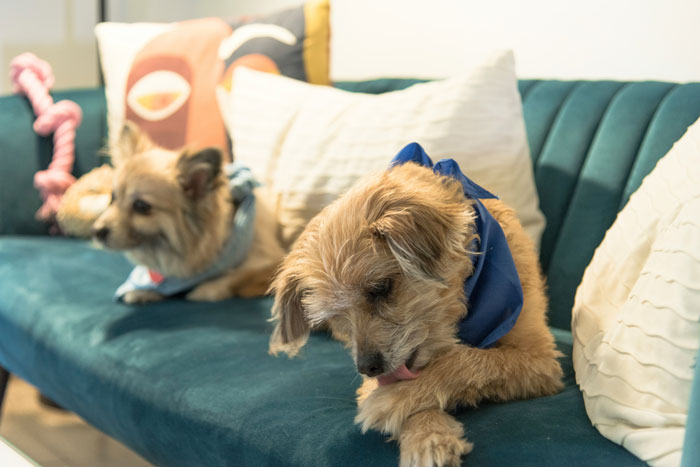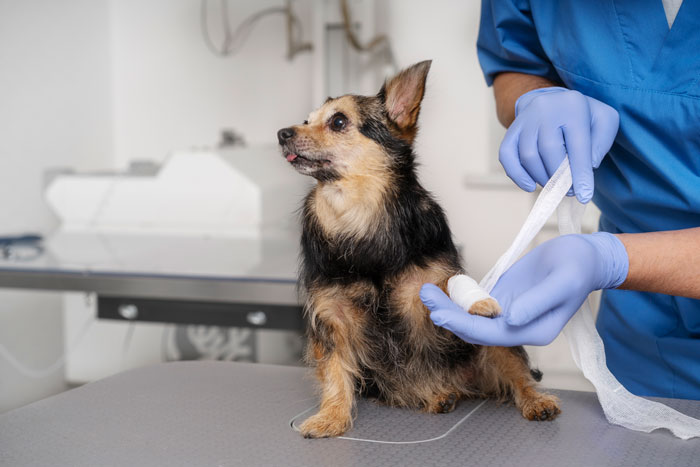
Can You Put Neosporin On A Dog? Benefits, Risks, And Alternatives
Canines are naturally curious, and if allowed, they’ll tirelessly explore the world around them for hours on end. No wonder their adventures often lead to minor cuts and scrapes.
When faced with a dog’s wound, your first instinct might be to reach for Neosporin. You probably even have some lying in a cabinet. But when it comes to treating wounds, a common over-the-counter antibiotic isn’t always the best option, according to vets.
- Neosporin is often not safe for dogs, posing risks like ingestion, allergic reactions, and hearing issues.
- Neosporin contains three antibiotics targeting various bacteria but is ineffective against viruses or fungi.
- Ingesting Neosporin can cause gastrointestinal distress in dogs, leading to symptoms like vomiting and diarrhea.
- Alternatives to Neosporin for dogs include antiseptic solutions, pet-safe antibiotic ointments, and natural remedies.
Bored Panda consulted a certified animal doctor, Dr.Majid Tanveer, to shed some light on the topic. Read on to find out why you should be careful when using Neosporin for dog wounds and what safe alternatives are.
The information provided herein is for informational purposes only. Please refer to our disclaimer for more details..
Is Neosporin Safe for Dogs?
No, it’s not safe to use Neosporin on dogs. While it might be safe for very minor, superficial cuts in some cases, there are risks, including the potential for licking and ingestion (causing upset stomach), allergic reactions, and possible hearing issues.
What is Neosporin?
Neosporin is a brand name for a popular over-the-counter ointment marketed as a “triple antibiotic.” It combines three topical antibiotics to fight infection in minor wounds. Here’s a breakdown of what’s in each tube:
Neomycin: This antibiotic is a broad-spectrum fighter, meaning it can kill a wide range of bacteria, both gram-positive (staph infections) and gram-negative (like E. coli).
Polymyxin B: This antibiotic also tackles a variety of bacteria, but it targets explicitly gram-negative bacteria. It works by disrupting their cell walls, making it difficult for them to survive.
Bacitracin: This antibiotic primarily targets gram-positive bacteria. It works by stopping them from building their cell walls, which are essential for survival.
While Neosporin is effective against many bacteria, it’s important to remember that it won’t work for everything. It’s not effective against viruses or fungi, which can also cause infections.
Potential Benefits of Using Neosporin on Your Dog
While it’s important to prioritize veterinarian-recommended treatments, there are a couple of limited scenarios where Neosporin might have some potential benefit for dogs:
Limited circumstances. In rare cases, your veterinarian might recommend applying Neosporin on a very minor, superficial cut or scrape on your dog. It’s essential to follow their instructions carefully.
Antibiotic action. The antibiotic ingredients in Neosporin can help fight against bacteria and potentially prevent infection from developing in minor wounds.
Neosporin should never be seen as a substitute for proper veterinary care, especially for anything more than a very minor superficial wound.
Risks and Side Effects of Using Neosporin on Dogs
While Neosporin might seem like a handy solution for use on dogs for minor scrapes, hidden dangers are lurking beneath that greasy ointment. Let’s delve deeper into the risks and disadvantages of using Neosporin on our canine companions.
Ingestion Risk
Dogs are notorious for their meticulous grooming habits. A scrape or cut quickly becomes a target for their tongues, making it nearly impossible to prevent them from licking off any medication applied topically. Here’s where the trouble with Neosporin begins.
Neosporin’s greasy texture makes it particularly appealing for a dog’s insistent licking. This increases the chances of them ingesting a significant amount of Neosporin.
Neomycin is one of the three antibiotics in Neosporin, and it poses a serious health risk if ingested by your dog. While small amounts might go unnoticed, larger quantities can lead to a domino effect of complications.
Gastrointestinal distress is highly likely when Neosporin is ingested. Imagine your dog’s stomach churning uncomfortably; that’s not exactly the help you intended to give your pup. Neomycin can wreak havoc on their digestive system, causing nausea, vomiting, and diarrhea. These symptoms, while unpleasant, can usually be managed with proper care. However, in severe cases, dehydration and electrolyte imbalance can become a concern, requiring veterinary intervention.
It’s important to know that even a small amount of Neosporin can cause upset if your dog ingests it.
Inner Ear Damage and Hearing Loss
This is where things get even more serious. Neomycin, at high doses, can have a devastating impact on your dog’s inner ear. This delicate structure can be damaged by Neomycin, potentially leading to partial or complete hearing loss. This risk is particularly concerning if you’re considering using Neosporin for long-term wound care or repeatedly on multiple wounds.
Allergic Reactions
Just like you can be allergic to certain things, your dog can be allergic to Neosporin. Here’s how your pup might react to this ointment.
Using Neosporin on your dog is like playing a guessing game. There’s no way to predict if they’ll have an allergic reaction or not. Even healthy, young pups can be sensitive to the ingredients.
Here’s how you can tell if your dog might be allergic to Neosporin:
- Increased redness in the wound area
- Swelling of the wound
- Itchiness
All of the above means your dog’s body is fighting against the Neosporin. Sometimes, pus might even appear, making things worse. Not only is this uncomfortable for your dog, but it can also slow healing.
The tricky part is that allergies and skin infections can look similar. They both can make the wound red, swollen, and even puss-filled. This can be confusing because you might think your dog’s wound is getting worse when it’s actually an allergic reaction, and vice versa.
Important: Contact your vet if you notice any problems after using Neosporin on your dog. They can help figure out what’s going on and get your furry friend feeling better faster.
Slow Healing
Our dog’s bodies are full of tiny living things that are too small to see, some helpful and some not so helpful. These tiny things, called bacteria, live together in a balance that helps wounds heal quickly. But a medicine like Neosporin can mess up this balance and slow down your dog’s healing.
Think of your dog’s wound like a battlefield. Bad bacteria are trying to cause an infection, and good bacteria are trying to heal the wound. Neosporin is like a bomb – it blows up everything in sight, both the bad and the good bacteria. While it gets rid of the bad guys, it also wipes out the good bacteria on the skin that helps heal the wound.
The good bacteria aren’t just sitting around; they’re busy helping your dog heal:
- They help build new skin, closing the wound faster.
- They fight off other bad bacteria that can make things worse.
By getting rid of the good bacteria, Neosporin can slow down your dog’s natural healing process. Without this helpful team, it takes longer for the wound to close up and your dog to feel better. So, next time your dog gets abrasion, it’s best to skip the Neosporin and talk to your vet about the best way to help them heal quickly.
Antibiotic Resistance
Antibiotics have been amazing for fighting infections, but we’ve been using them a little too much, and that’s causing a big problem. This includes using Neosporin on pets, which has an antibiotic called Neomycin. Here’s how it works:
When we use antibiotics frequently, bacteria can develop resistance to them by building shields. These shields make regular antibiotics ineffective, resulting in the creation of “superbugs” that are tough to treat. Superbugs are bacteria that have become resistant to antibiotics, and their proliferation poses a significant challenge for modern medicine.
Dr. Rachel Barrack, a licensed veterinarian and founder of Animal Acupuncture in New York City, states, “Neosporin is formulated for humans and isn’t ideal for dogs. While bacitracin and polymyxin B are safe for animals, neomycin has potential side effects.”
When is Neosporin Okay to Use?
When approved by your vet, a bit of Neosporin or another triple antibiotic ointment is the best choice. Neosporin is used on dogs for minor cuts and to prevent infection in minor wounds. While Neosporin is generally safe for minor cuts and scrapes, always consult your veterinarian before using it, especially if the wound is deep or your dog is prone to licking.
When to Seek Veterinary Advice
Don’t forget Neosporin isn’t a magic cure and won’t replace a trip to the vet. There are times when your pup absolutely needs a professional to take a look at their wound. Head to the vet if you face any of the following issues.
Deep cuts. If the wound looks deep and goes through several layers of skin, get your dog to the vet. These wounds have a higher chance of infection and might need stitches to heal properly.
Signs of infection. Watch out for redness, swelling, pus, or a bad smell from the wound. These could be signs of infection, which need a vet’s attention and might involve antibiotics.
Bleeding that won’t stop. If your dog’s wound is bleeding a lot or you can’t stop the bleeding with basic first aid, take them to the vet right away.
Painful wounds. If your dog seems in a lot of pain or the wound is super sensitive when you touch it, don’t wait; see the vet.
Unsure about the wound. When in doubt, always check with your vet! They’re the experts and can tell you the best way to care for your furry friend’s wound.
Safe Alternatives to Neosporin for Dog Wounds
You can do some things at home to help your dog’s wound heal, but it’s always best to check with your vet first. They can recommend the safest and most effective treatment for your pup.
Here are some options your vet might suggest.
Cleaning the wound. You can use a special antiseptic solution like chlorhexidine or diluted povidone-iodine to clean the wound gently. Make sure to get the okay from your vet and follow their instructions for dilution.
Antibiotic ointment. If your dog needs extra help fighting infection, your vet might prescribe a pet-safe antibacterial ointment. This is usually a better option than over-the-counter ointments like Neosporin.
Preventing licking. If your dog keeps licking their wound, it can slow healing or cause an infection. Your vet might recommend an e-collar (cone) to keep them from reaching the area.
Bandages. In some cases, a bandage might be needed to protect the wound and aid healing. Your vet will show you how to apply and care for the bandage properly.
Natural Alternatives to Neosporin for Dogs
Here are some safe and natural alternatives that you can try after a gentle cleaning of the wound.
Diluted apple cider vinegar. This has antibacterial properties and can be used on your dog’s minor wounds.
Herbal rinses. Chamomile or calendula tea can soothe the area your dog can lick.
Manuka honey. This special honey is a natural healer! Use manuka honey on your dog for minor cuts or itchy skin, but keep a close eye to prevent licking.
Coconut oil. This moisturizer can help soothe irritated skin.
166views
Share on Facebook Image credits:
Image credits:  Image credits:
Image credits:  Image credits:
Image credits: 


5
1